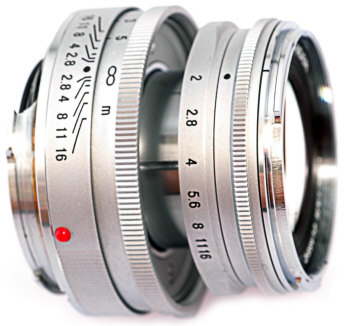Voigtlander Bessa R3a
Primary Use: This is my go to camera, and is usually pared with my Voigtlander Classic Heliar 50mm f2.
Design: Modern 35mm rangefinder with optional aperture priority exposure.
Advantages: Hot shoe, AE mode, With kids, it is more convenient to just to have AE, instead of having to set exposure as well as focus. 1:1 finder, meaning I could shoot with both eyes open. It's lower cost and less sentimental that the M3, so I feel more comfortable taking it on vacations.
Disadvantages: Can't use my Leitz Summicron 50/2 DR due to internal obstructions. Shorter rangefinder baseline makes it somewhat more difficult to focus at wide apertures
Leica M3
Primary Use: When I shoot black & white, and it's often paired with the Leitz Summicron 50/2 DR. Also when a very quiet shutter is needed (such as a wedding);
Design: Early 1960s mechanical 35mm rangefinder. Some say its the classic camera. It's been owned in my family since purchased new in the 1960s. It has framelines for 50mm, 90mm, and 135mm which makes shoot a 35mm lens more difficult, but makes focus at 50mm at f/1.52 more accurate. I usually use the 50mm since I am photographing the kids.
Advantages: Quiet shutter, easy to focus long focal lengths and/or wide apertures, built like a tank
Disadvantages: No hot shoe, slower film loading
Rolleiflex MV-EVS II
Primary Use: This has become my primary portrait camera. The 75mm focal length allows me to seperate the subject from the background, even stopped down, but since it is medium format, 75mm is a "normal view."
Design: A twin lens reflex (circa 1955) which shoots 12 frames on 120 film. It has a 75mm f/3.5 Zeiss Tessar lens. The big 6x6 negative offers rich detail.
Advantages: Low cost way to get high quality medium format pictures. (Cost about $180). Easy focus. Easy ability to mount filters and other lens accessories
Disadvantages: Too heavy and bulky for long travel. With 12 shots per roll, situations where you take a lot of pictures and need to change rolls quickly (wedding, kids birthday party, etc), increases the likelihood that you might miss a shot. Using a flash requires a flash bracket (unless you are using the flash bulb attachment as shown below). No hot or cold shoe to mount accessories, such as a light meter. No light meter.
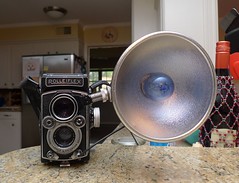
Leica IIIa
Primary Use: Pocketable camera when I want a longer focal length. I rather recently used it at a concert
Design: Older screwmount rangefinder which was made in 1938. I usually use a collapsible Leitz Elmar 50/3.5 or a collapsible Leitz Summitar 50/2.
Advantages: Much more pocketable than a Leica M or other cameras
Disadvantages: Viewfinder is only for a 50mm lens, so an accessory viewfinder would be needed for other focal lengths. The rangefinder is seperate from the viewfinder, so it is slower to use
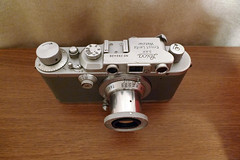
Zeiss Mess Ikonta 524/2
Primary Use: Travel camera when I want negatives that could be greatly enlarged. I enlarged one from my trip to London and Denmark to 24" x 36".
Design: Folding medium format camera with a coated 105/3.5 Zeiss Tessar lens and a Synchro-Compur shutter. Produces 6x9 images on 120 film. Produced the early-mid 1950s.
Advantages: Very pocketable. Uncoupled rangefinder. Many folders did not have a way to measure distance
Disadvantages: Focusing is slow, although most shots are at infiniti anyway.
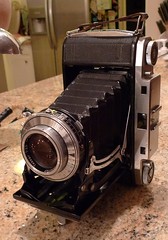
Zeiss Ikonta 523/16
Primary Use: Potential travel camera or for a day outing when you want just a few images but of higher quality.
Design: Folding medium format camera made by Carl Zeiss with a coated 7.5/3.5 Zeiss Tessar lens and a Synchro-Compur shutter. Produces 6x6 images on 120 film
Advantages: Pocketable medium format
Disadvantages: Scale (guess) focusing and would require an accessory viewfinder (shown below)
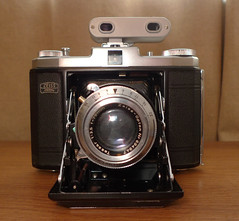
Ansco Speedex B2
Primary Use: Experimental photography - such as double exposures or light graffiti. I've put two rolls through it to date.Design: Older screwmount rangefinder which was made in 1938. I usually use a collapsible Leitz Elmar 50/3.5 or a collapsible Leitz Summitar 50/2.
Advantages: Much more pocketable than a Leica M or other cameras
Disadvantages: Viewfinder is only for a 50mm lens, so an accessory viewfinder would be needed for other focal lengths. The rangefinder is seperate from the viewfinder, so it is slower to use

Zeiss Mess Ikonta 524/2
Primary Use: Travel camera when I want negatives that could be greatly enlarged. I enlarged one from my trip to London and Denmark to 24" x 36".
Design: Folding medium format camera with a coated 105/3.5 Zeiss Tessar lens and a Synchro-Compur shutter. Produces 6x9 images on 120 film. Produced the early-mid 1950s.
Advantages: Very pocketable. Uncoupled rangefinder. Many folders did not have a way to measure distance
Disadvantages: Focusing is slow, although most shots are at infiniti anyway.

Zeiss Ikonta 523/16
Primary Use: Potential travel camera or for a day outing when you want just a few images but of higher quality.
Design: Folding medium format camera made by Carl Zeiss with a coated 7.5/3.5 Zeiss Tessar lens and a Synchro-Compur shutter. Produces 6x6 images on 120 film
Advantages: Pocketable medium format
Disadvantages: Scale (guess) focusing and would require an accessory viewfinder (shown below)

Ansco Speedex B2
Design: Folding medium format camera with a uncoated 7.5/3.5 Afga lens (which is likely a Cooke triplet type_ and 7 speed shutter. Produces 6x6 images on 120 film. Made around 1940.
Advantages: Ability to make double exposures
Disadvantages: No protection against double exposures.
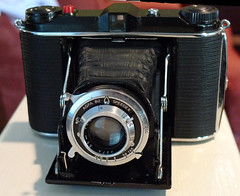
TDC Stereo Colorist II
Primary Use: Three dimension photos! I've taken two rolls, one per year.
Design: Two Rodenstock Trinar (Cooke Triplet style) 35mm f/3.5 lenses. Produced around 1954.
Advantages: Normal viewfinder (as opposed to the Stereo Realist), coupled rangefinder, and a hot shoe (somewhat uncommon). See full review here
Disadvantages: Mounting slides (common to any stereo camera) is long process.
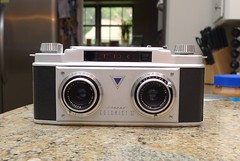
Olympus Stylus Epic II (mju II)
Primary Use: Very pocketable 35mm camera for days when small size matters the most.
Design: Tiny automatic with a sharp 35mm f/2.8 lens from about 1997.
Advantages: Auto focus, auto load, built in flash
Disadvantages: Controls are limited to flash on or off. Primary Use: Very pocketable 35mm camera for days when small size matters the most.
Design: Tiny automatic with a sharp 35mm f/2.8 lens from about 1997.
Advantages: Auto focus, auto load, built in flash
Bottom photo, next to an Olympus XA (which I no longer own)

Pentax ZX-60
Primary Use: When I need a long zoom. (once a year)
Design: Automatic 35mm SLR.
Advantages: Autofocus, TTL Flash, TTL metering. Sometimes you just can't take your time.
Disadvantages: BulkyPrimary Use: When I need a long zoom. (once a year)
Design: Automatic 35mm SLR.
Advantages: Autofocus, TTL Flash, TTL metering. Sometimes you just can't take your time.
On the left (compared to a Voigtlander Bessa R, which I no longer own):

Zeiss Ikonta A
Primary Use: An even more pocketable MF folder. Sitting on shelf looking pretty with its Art Deco styling
Design: Folding medium format that produced 6x4.5 images on 120 film. Made by Zeiss Ikon in the early 1930s and features an uncoated Zeiss Tessar and a Compur shutter
Advantages: very pocketable
Disadvantages: currently the bellows have pinhole leaks. Shutter release is only on the lens, not the body.

Olympus OM-2n
Primary Use: None for me right now
Design: Manual focus SLR with AE exposure from about 1978.
Advantages: Many including price if you want to shoot film. See full review
Disadvantages:
At the bottom, below the Leica M3
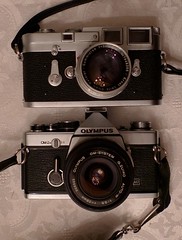
Minitature Speed Graphic
Primary Use: I've used it a few times, but none really. Perhaps if I just want one MF shot.
Design: Press camera with uncoated 105mm f/3.5 Zeiss Tessar and makes images on 2 1/4" x 3 1/4" sheet film.
Advantages: I can take one shot and develop one shot. No waiting until the roll is finished.
Disadvantages: Too bulky and slow for practical regular photography outside the home. Only Efke makes sheet film in this size.
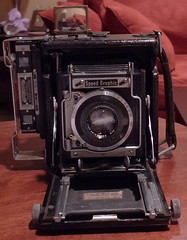
Ansco Memo
Primary Use: Sitting on my shelf, looking pretty. (It belonged to my grandfather)
Design: Half frame 35mm camera, produced in about 1928. It has three speed (25, 50, 100) plus T & B. The aperature range is f/6.3 to f/16.
Advantages: Takes up a little space on my shelf
Disadvantages: While it takes 35mm film, it would have to be loaded in special cassettes



